Protocol - Body Image
- Maximum Adult Height
- Maximum Adult Weight
- Weight - Measured Weight
- Weight - Self-Reported Weight
- Weight Loss/Gain
Description
This protocol encompasses the self-reported prior, current, or ideal body image of the respondents and their children. The majority of studies using pictograms have used the Stunkard Figure Rating Scale, which contains nine silhouettes on an ordinal scale. An alternative, the Collins scale, has also been provided. Specific pictograms for African Americans and children are also included.
Specific Instructions
Participants are instructed to choose the picture from the pictogram that they think represents their actual size at a specific age or, as instructed and when appropriate, circle the size they would ideally like to be at another age or currently. The pictograms can also be used to provide input on body size or body image of participants’ children. Proxy assessments are appropriate for participants’ children only and not for other adults. See Protocol Text for more detail.
Availability
This protocol is freely available; permission not required for use.
Protocol
The following protocol is taken from a personal interview study in which study participants are asked to self-report about their own body image and then report about first-degree family members. Please refer to the following adult and child pictures below to answer the following questions about yourself and your first-degree family members (e.g., mother, father, and/or children). TO BEGIN: Step 1: Look at the pictures below of males or females and try to choose the picture that most closely resembles how you looked at each age listed below. Step 2: Look at the adult and child pictures. Choose the picture that most closely resembles your (or your child’s) body shape right now and at the ages of 5, 10, and 20. The child pictures should be used for ages 5 & 10 and the adult pictures for ages 20 or older. Editor’s Note: The participant is shown pictures that display various body shapes associated with a scale. For adults, three scales are provided here. The Stunkard graphics show nine images for men and for women. Consequently, the responses should be recorded on a form that includes 1 through 9. Pulvers et al. provided graphics validated for African American men and women on a 1 to 9 scale. Collins presents a range of seven male and seven female figures. Consequently, the forms indicated can be used with those graphics. (The Working Group was not aware of other population-specific graphics.) For children, Collins provides graphics for boys and for girls on a 1 to 7 scale. All graphics are provided below.

PARTICIPANT (Stunkard or Pulvers Scale)

PARTICIPANT (Collins Scale)

PARTICIPANT’S CHILDREN (Collins Scale)

PARTICIPANT’S CHILDREN (Collins Scale)
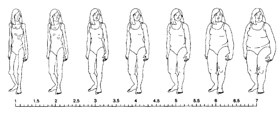
Collins Adult Female
Editor’s Note: To score this scale, please record a number 1 through 7 corresponding to the figure the respondent indicates for the Collins scale. Adapted from Collins, M. E. (1991). Body figure perceptions and preferences among preadolescent children. International Journal of Eating Disorders, 10, 199-208.

Stunkard Adult Female
Editor’s Note: To score this scale, please record 1 through 9 corresponding to the figure the respondent indicates for the Stunkard scale. Adapted from Stunkard, A. J., Sorensen, T., & Schulsinger, F. (1983). Use of the Danish Adoption Register for the study of obesity and thinness. Research Publications - Association for Research in Nervous and Mental Disease, 60, 115-120.
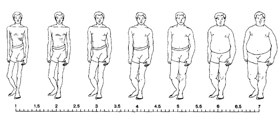
Collins Adult Male
Editor’s Note: To score this scale, please record a number 1 through 7 corresponding to the figure the respondent indicates for the Collins scale. Adapted from Collins, M. E. (1991). Body figure perceptions and preferences among preadolescent children. International Journal of Eating Disorders, 10, 199-208.
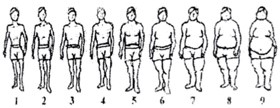
Stunkard Adult Male
Editor’s Note: To score this scale, please record 1 through 9 corresponding to the figure the respondent indicates for the Stunkard scale. Adapted from Stunkard, A. J., Sorensen, T., & Schulsinger, F. (1983). Use of the Danish Adoption Register for the study of obesity and thinness. Research Publications - Association for Research in Nervous and Mental Disease, 60, 115-120.
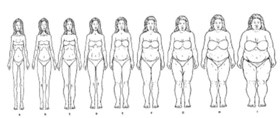
Pulvers Adult African American Female
Editor’s Note: To score this scale, please record a number 1 through 9 corresponding to the figure the respondent indicates for the Pulvers scale. Adapted from Pulvers, K. M., Lee, R. E., Kaur, H., Mayo, M. S., Fitzgibbon, M. L., Jeffries, S. K., Butler, J., Hou, Q., & Ahluwalia, J. S. (2004). Development of a culturally relevant body image instrument among urban African Americans. Obesity Research, 12, 1641-1651.
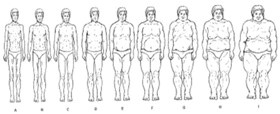
Pulvers Adult African American Male
Editor’s Note: To score this scale, please record a number 1 through 9 corresponding to the figure the respondent indicates for the Pulvers scale. Adapted from Pulvers, K. M., Lee, R. E., Kaur, H., Mayo, M. S., Fitzgibbon, M. L., Jeffries, S. K., Butler, J., Hou, Q., & Ahluwalia, J. S. (2004). Development of a culturally relevant body image instrument among urban African Americans. Obesity Research, 12, 1641-1651.
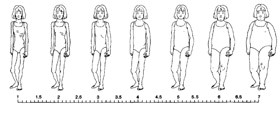
Collins Child Female
Editor’s Note: To score this scale, please record a number 1 through 7 corresponding to the figure the respondent indicates for the Collins scale. Adapted from Collins, M. E. (1991). Body figure perceptions and preferences among preadolescent children. International Journal of Eating Disorders, 10, 199-208.
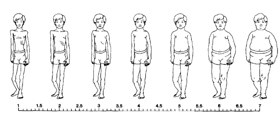
Collins Child Male
Editor’s Note: To score this scale, please record a number 1 through 7 corresponding to the figure the respondent indicates for the Collins scale. Adapted from Collins, M. E. (1991). Body figure perceptions and preferences among preadolescent children. International Journal of Eating Disorders, 10, 199-208.
Personnel and Training Required
None
Equipment Needs
Flash cards depicting body image scales
Requirements
| Requirement Category | Required |
|---|---|
| Major equipment | No |
| Specialized training | No |
| Specialized requirements for biospecimen collection | No |
| Average time of greater than 15 minutes in an unaffected individual | No |
Mode of Administration
Self- or proxy-reported value
Lifestage
Child, Adolescent, Adult, Senior
Participants
Participant aged 6 years or older for self-report
Selection Rationale
Pictograms have been associated with health outcomes including diabetes, hypertension, coronary disease, and mental health status. They may be used to identify current, younger, and/or ideal body image; and when used to assess image over time, a chronological approach for age-specific groups has been used. That is, the figures have been assigned body mass index (BMI, kg/m2) percentiles and age-appropriate BMI for tracking relative weight changes (loss or gain) from childhood through adulthood. Use of an ethnic group-specific body image is advisable because size and perception may vary by ethnicity.
Language
Chinese, English
Standards
| Standard | Name | ID | Source |
|---|---|---|---|
| Logical Observation Identifiers Names and Codes (LOINC) | Body image proto | 63522-7 | LOINC |
| caDSR Form | PhenX PX020401 - Body Image | 5800840 | caDSR Form |
Derived Variables
None
Process and Review
The Expert Review Panel #1 reviewed the measures in the Anthropometrics, Diabetes, Physical Activity and Physical Fitness, and Nutrition and Dietary Supplements domains.
Guidance from the ERP includes:
• Revised descriptions of measure
Back-compatible: no changes to Data Dictionary
Previous version in Toolkit archive (link)
Protocol Name from Source
Body Figure Perceptions Scales from Collins, Stunkard et al., and Pulvers et al.
Source
Collins, M. E. (1991). Body figure perceptions and preferences among preadolescent children. International Journal of Eating Disorders, 10, 199-208.
Pulvers, K. M., Lee, R. E., Kaur, H., Mayo, M. S., Fitzgibbon, M. L., Jeffries, S. K., . . . Ahluwalia, J. S. (2004). Development of a culturally relevant body image instrument among urban African Americans. Obesity Research, 12, 1641-1651.
Stunkard, A. J., Sorensen, T., & Schulsinger, F. (1983). Use of the Danish Adoption Register for the study of obesity and thinness. Research Publications - Association for Research in Nervous and Mental Disease, 60, 115-120.
General References
Cachelin, F. M., Monreal, T. K., & Juarez, L. C. (2006). Body image and size perceptions of Mexican American women. Body Image, 3(1), 67-75.
Costello, E. J., Sung, M., Worthman, C., & Angold, A. (2007). Pubertal maturation and the development of alcohol use and abuse. Drug and Alcohol Dependence, 88(Suppl. 1), S50-S59.
Doswell, W. M., Millor, G. K., Thompson, H., & Braxter, B. (1998). Self-image and self-esteem in African-American preteen girls: Implications for mental health. Issues in Mental Health Nursing, 19(1), 71-94.
Graber, J. A., Seeley, J. R., Brooks-Gunn, J., & Lewinsohn, P. M. (2004). Is pubertal timing associated with psychopathology in young adulthood? Journal of the American Academy of Child and Adolescent Psychiatry, 43(6), 718-726.
Maximova, K., McGrath, J. J., Barnett, T., O’Loughlin, J., Paradis, G., & Lambert, M. (2008). Do you see what I see? Weight status misperception and exposure to obesity among children and adolescents. International Journal of Obesity, 32(6), 1008-1115.
Must, A., Phillips, S. M., Stunkard, A. J., & Naumova, E. N. (2002). Expert opinion on body mass index percentiles for figure drawings at menarche. International Journal of Obesity, 26(2), 876-879.
Olvera, N., Suminski, R., & Power, T. G. (2005). Intergenerational perceptions of body image in Hispanics: Role of BMI, gender, and acculturation. Obesity Research, 13(11), 1970-1979.
Siegel, J. M., Yancey, A. K., Aneschensel, C. S., & Schuler, R. (1999). Body image, perceived pubertal timing, and adolescent mental health. Journal of Adolescent Health, 25(2), 155-165.
Snooks, M. K., & Hall, S. K. (2002). Relationship of body size, body image, and self-esteem in African American, European American, and Mexican American middle-class women. Health Care for Women International, 23(5), 460-466.
Protocol ID
20401
Variables
Export Variables| Variable Name | Variable ID | Variable Description | dbGaP Mapping | |
|---|---|---|---|---|
| PX020401_Body_Image_10 | ||||
| PX020401020200 | Choose the picture that most closely more | N/A | ||
| PX020401_Body_Image_10_Scale | ||||
| PX020401020300 | Scale Used for Child Body Image. | N/A | ||
| PX020401_Body_Image_20 | ||||
| PX020401030200 | Choose the picture that most closely more | N/A | ||
| PX020401_Body_Image_20_Scale | ||||
| PX020401030300 | Scale Used for Adult Body Image. | N/A | ||
| PX020401_Body_Image_30 | ||||
| PX020401040200 | Choose the picture that most closely more | N/A | ||
| PX020401_Body_Image_30_Scale | ||||
| PX020401040300 | Scale Used for Adult Body Image. | N/A | ||
| PX020401_Body_Image_40 | ||||
| PX020401050200 | Choose the picture that most closely more | N/A | ||
| PX020401_Body_Image_40_Scale | ||||
| PX020401050300 | Scale Used for Adult Body Image. | N/A | ||
| PX020401_Body_Image_5 | ||||
| PX020401010200 | Choose the picture that most closely more | N/A | ||
| PX020401_Body_Image_5_Scale | ||||
| PX020401010300 | Scale Used for Child Body Image. | N/A | ||
| PX020401_Body_Image_Current_Age | ||||
| PX020401060200 | Choose the picture that most closely more | N/A | ||
| PX020401_Body_Image_Current_Age_Scale | ||||
| PX020401060300 | Scale Used for Adult Body Image. | N/A | ||
| PX020401_Body_Image_Gender_10 | ||||
| PX020401020100 | Male or female pictures presented/chosen for more | N/A | ||
| PX020401_Body_Image_Gender_20 | ||||
| PX020401030100 | Male or female pictures presented/chosen for more | N/A | ||
| PX020401_Body_Image_Gender_30 | ||||
| PX020401040100 | Male or female pictures presented/chosen for more | N/A | ||
| PX020401_Body_Image_Gender_40 | ||||
| PX020401050100 | Male or female pictures presented/chosen for more | N/A | ||
| PX020401_Body_Image_Gender_5 | ||||
| PX020401010100 | Male or female pictures presented/chosen for more | N/A | ||
| PX020401_Body_Image_Gender_Current_Age | ||||
| PX020401060100 | Male or female pictures presented/chosen more | N/A | ||
Measure Name
Body Image
Release Date
March 27, 2009
Definition
Self-reported body size using a visual scale at selected ages and/or currently; or parents’ perception of their child’s body size.
Purpose
This measure is used to assess an individual’s perception of his or her (and his or her children’s) body image. Self body image historically and currently, and body image of one’s children, is a useful indicator of health (i.e., predictive of weight status, diabetes, hypertension, and coronary disease) and mental well-being. Also, differences between self-perceived body image and measured status have been used to evaluate distorted body image in studies of eating disorders or other psychological or behavioral factors.
Keywords
Anthropometrics, body mass index, BMI, mental health, Collins Scale, Pulvers Scale, Stunkard Scale, body image scales
Measure Protocols
| Protocol ID | Protocol Name |
|---|---|
| 20401 | Body Image |